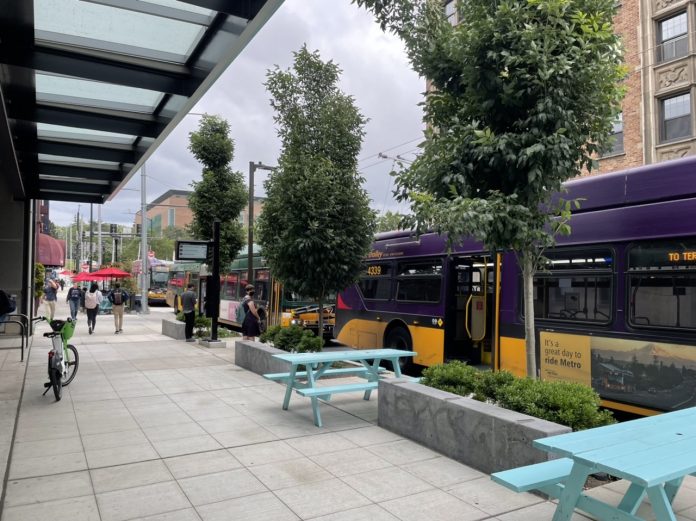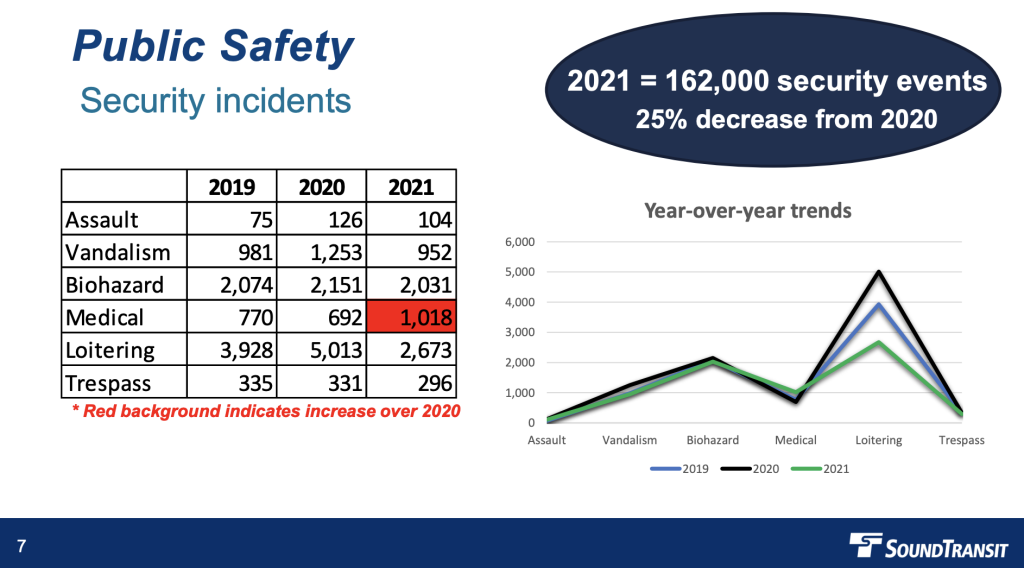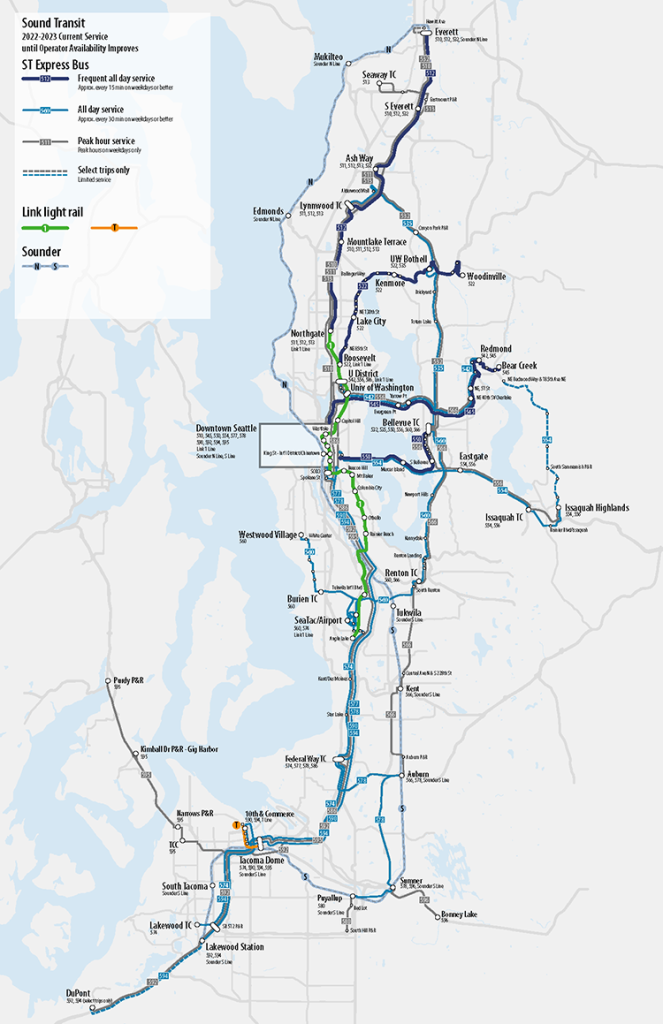This Transpo Notes roundup touches on a mix of transit stories, including:
- New digital advertising screens appearing at Link stations;
- Security incident trends on Sound Transit;
- Sound Transit’s draft for a realistic 2023 service plan; and
- Sound Transit’s disparate impact and disproportionate burden policy revisions.
New Link station digital advertising screens now arriving
Link riders might soon start notice digital advertising screens appearing at stations. On Wednesday, Urbanist transportation reporter Ryan Packer tweeted about several screens at Capitol Hill Station. Reached by email, Sound Transit spokesperson John Gallagher shared that the pilot program will total 20 screens, including “two screens in UW Station, four in Capitol Hill, six in Westlake, six in University Street, one at Stadium and one at SeaTac/Airport.”
Only three stations currently feature operating screens, Gallagher said, including University Street, University of Washington, and Capitol Hill Stations, but this trend should ramp up quickly with “all but three screens…functioning by mid-to-late August.” Gallagher added that “the final three screens in Westlake won’t be installed until late October once the ticket vending machines are removed in that station to make room for them.”
The screens were originally planned for installation beginning in the spring, but detailed engineering was still underway at the time. More stations will eventually get digital advertising screens, which increasingly provide revenue to the agency. By year 13 of the deal with Intersection — the company providing the screens — revenue will reach nearly $2 million per year with only a very modest prevalence of screens. As part of the deal, Sound Transit will eventually get to own the equipment outright, while Intersection will be responsible for maintenance of it. Sound Transit will also be able to use some ad space for agency campaigns, such as customer etiquette and safety messages.
Security incidents on the decline on Sound Transit but still elevated
In absolute numbers, Sound Transit has seen safety improvement across the transit system since 2020. Reported security events fell 25% in 2021 across all categories except for medical incidents. Rates of vandalism, biohazards, loitering, and trespass were all below 2019 numbers. However, medical incidents reached 1,018, far above the 692 and 770 incidents reported in 2020 and 2019 respectively.
Agency staff said that the biggest reason for the increase in medical events was drugs, particularly from fentanyl overdoses. This has been problematic on Link trains and in Link stations where drug users are consuming drugs, though some people involved in these medical events are simply arriving in the Link system after drug use and then overdosing. Agency staff and first responders have protocols in place to address medical events, but they can be disruptive to service and generally traumatic events. The increasing trend of medical events is concerning and mirrors increases in fentanyl overdoses across King County.
A big caveat to consider alongside the improved safety trends is that Link ridership on balance was still down in 2021 over 2019. That means the number of security incidents in relation to ridership is actually still elevated, and therefore, more frequently experienced by riders than in the past. On Saturday, a serious incident occurred on a Link train headed to Stadium Station when a rider pepper sprayed about eight other riders and then fled the scene.
At last week’s meeting, King County Councilmember Claudia Balducci, a Sound Transit boardmember, mentioned that a rider at the Bellevue Transit Center was brutal beaten in mid-July and later died from injuries sustained during the attack. She said that safety needs to be a top priority to maintain rider confidence. ”Part of providing a system where people need to go is ensuring they’re safe when doing it,” Balducci said.
Sound Transit does have a contract with the King County Sheriff’s Office for patrols and contracts with three security companies. To deal with staffing challenges, the agency approved another security contract with a vendor for services in July. The agency is also evaluating activation strategies at stations, particularly at Mount Baker to promote community, economic development, and safety.
Sound Transit’s draft 2023 Service Plan isn’t optimistic
Sound Transit is seeking feedback on its 2023 Service Plan through August 16th. By and large, the proposed service plan acknowledges the staffing shortages transit agencies are facing regionally and doesn’t anticipate significant resolution to planned service delivery across the ST Express bus network. Link and Sounder have managed to see some service restoration — though the latter has experienced widespread delays and mismanagement by the contractor.
In 2021, the agency had developed a much more optimistic plan to increase and consolidate ST Express bus service for Pierce County and Snohomish County routes. While Route 535 improvements were partially realized, the plans largely stumbled as retirements, resignations, and promotions of transit operators forced emergency reductions on bus routes, including reductions of about 20% on Pierce Transit-operated routes, 10% on Community Transit-operated routes, and 5% on King County Metro-operated routes. Sound Transit did take strides to lessen the pain by moving operations of Route 566 from Pierce Transit to Metro in order to stave off further service reductions.
Functionally, the service plan doesn’t change planned services, keeping the door open to service restorations and plan implementation if staffing circumstances improve. Sound Transit expects lower service levels on Routes 566, 577, 590, and 592 compared to approved service levels and substantial changes to Route 580. The service plan proposes deletion of Route 580’s SR 512 segment, which includes stops at SR 512 Park-and-Ride and Lakewood Station. Instead, Route 580 would only operate between Puyallup Station, Red Lot, and South Hill Park-and-Ride and its service would be coordinated with Pierce Transit’s Route 400 to meet specific Sounder trips.
| Route | Approved/Target Service Levels | Current Service Levels |
| 566 | Weekday peak: 20-minute frequency | Weekday peak: 20- to 40-minute frequency |
| 577 (combined with 578) | Weekday peak: 6- to 8-minute frequency Weekday midday: 15-minute frequency Weekday evenings: 30-minute frequency Weekday late nights: 30-minute frequency Weekends: 15-minute frequency | Weekday peak: 10- to 12-minute frequency Weekday midday: 30-minute frequency Weekday evenings: 30- to 60-minute frequency Weekday late nights: 30-minute frequency Weekends: 30- to 60-minute frequency |
| 590 (combined with 594) | Weekday peak: 6- to 9-minute frequency Weekday midday: 15-minute frequency Weekday evenings: 30-minute frequency Weekday late nights: 30-minute frequency Weekends: 15- to 30-minute frequency | Weekday peak: 10-minute frequency Weekday midday: 30-minute frequency Weekday evenings: 30-minute frequency Weekday late nights: 30-minute frequency Weekends: 30-minute frequency |
| 592 | Weekday peak: 20-minute frequency | Weekday peak: 30-minute frequency |
It’s hard to be optimistic about the transit operator shortage, in part because local elected officials have shown no signs and sympathy for service reductions across the transit system. Their lack of action is directly exacerbating a decline in transit service even though they have many tools at their disposal to improve the staffing circumstances.
Sound Transit adopts Title VI-related disparate impact and disproportionate burden policy revisions
Last week, the Sound Transit board adopted updates to the agency’s disparate impact and disproportionate burden policies for populations protected by Title VI, which prohibits discrimination on the basis of race, color, or national origin in any program or activity that receives Federal funding. The Federal Transit Administration requires local transit agencies to measure impacts from decisions in relation to these policies to understand how low-income and minority populations might be impacted. The changes are as follows:
| Topic | Current | Newly Adopted |
| Determining if a service change is “major” | 25% change in platform hours and/or one-half mile (bus) or one-half mile (rail) change in stop location | 25% change in revenue hours and/or one-quarter mile (bus) or one-half mile (rail) change in stop location |
| Protected route threshold for low-income and minority populations | Any numerical difference above district average (anything above 0%) identifies a protected route | 5% absolute difference for changes identifies a protected route |
| Benefits and impacts to protected and non-protected populations on all routes with changes over multiple years | For all changes implemented in past two years and proposed changes for next year | 20% more negative impact or less benefit to protected populations identifies potential equity impact |
| Fare change impact of protected populations | Any numerical difference from system average identifies a potential equity impact | 20% more impact to protected populations using relative difference (ratio) identifies potential equity impact |
| Facility siting impacts to protected populations | No explicit policy in place, but any numerical difference from system average used to identify a potential equity impact | 5% absolute difference from system average identifies a potential equity impact |
Stephen is a professional urban planner in Puget Sound with a passion for sustainable, livable, and diverse cities. He is especially interested in how policies, regulations, and programs can promote positive outcomes for communities. With stints in great cities like Bellingham and Cork, Stephen currently lives in Seattle. He primarily covers land use and transportation issues and has been with The Urbanist since 2014.




